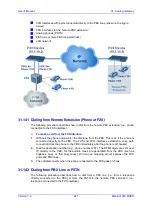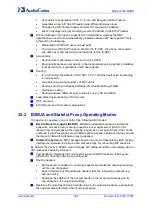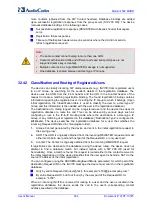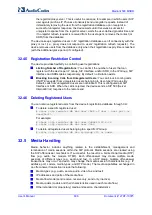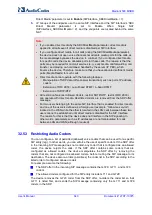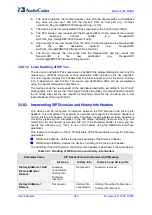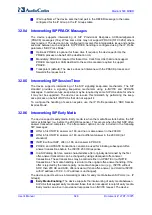
User's Manual
634
Document #: LTRT-10375
Mediant 500 MSBR
more contacts (obtained from the SIP Contact headers). Database bindings are added
upon successful registration responses from the proxy server (SIP 200 OK). The device
removes database bindings in the following cases:
Successful de-registration responses (REGISTER with Expires header that equals
zero).
Registration failure responses.
Timeout of the Expires header value (in scenarios where the UA did not send a
refresh registration request).
Note:
•
The same contact cannot belong to more than one AOR.
•
Contacts with identical URIs and different ports and transport types are not
supported (same key is created).
•
Multiple contacts in a single REGISTER message is not supported.
•
One database is shared between all User-type IP Groups.
32.4.2 Classification and Routing of Registered Users
The device can classify incoming SIP dialog requests (e.g., INVITE) from registered users
to an IP Group, by searching for the sender’s details in the registration database. The
device uses the AOR from the From header and the URL in the Contact header of the
request to locate a matching registration binding. The found registration binding contains
information regarding the registered user, including the IP Group to which it belongs. (Upon
initial registration, the Classification table is used to classify the user to a User-type IP
Group and this information is then added with the user in the registration database.)
The destination of a dialog request can be a registered user and the device thus uses its
registration database to route the call. This can be achieved by various ways such as
configuring a rule in the IP-to-IP Routing table where the destination is a User-type IP
Group or any matching user registered in the database ('Destination Type' is configured to
All Users
). The device searches the registration database for a user that matches the
incoming Request-URI (listed in chronological order):
1.
Unique Contact generated by the device and sent in the initial registration request to
the serving proxy.
2.
AOR. The AOR is originally obtained from the incoming REGISTER request and must
either match both user part and host part of the Request-URI, or only user part.
3.
Contact. The Contact is originally obtained from the incoming REGISTER request.
If registrations are destined to the database (using the above rules), the device does not
attempt to find a database match, but instead replies with a SIP 200 OK (used for
Survivability). Once a match is found, the request is routed either to the contact received in
the initial registration or (if the device identifies that the user agent is behind a NAT) to the
source IP address of the initial registration.
You can configure (using the SBCDBRoutingSearchMode parameter) for which part of the
destination Request-URI in the INVITE message the device must search in the registration
database:
Only by entire Request-URI (user@host), for example, "[email protected]".
By entire Request-URI, but if not found, by the user part of the Request-URI, for
example, "4709".
When an incoming INVITE is received for routing to a user and the user is located in the
registration database, the device sends the call to the user's corresponding contact
address specified in the database.
Summary of Contents for Mediant 500 MSBR
Page 2: ......
Page 33: ...Part I Getting Started with Initial Connectivity ...
Page 34: ......
Page 36: ...User s Manual 36 Document LTRT 10375 Mediant 500 MSBR This page is intentionally left blank ...
Page 40: ...User s Manual 40 Document LTRT 10375 Mediant 500 MSBR This page is intentionally left blank ...
Page 45: ...Part II Management Tools ...
Page 46: ......
Page 48: ...User s Manual 48 Document LTRT 10375 Mediant 500 MSBR This page is intentionally left blank ...
Page 115: ...Part III General System Settings ...
Page 116: ......
Page 132: ...User s Manual 132 Document LTRT 10375 Mediant 500 MSBR This page is intentionally left blank ...
Page 137: ...Part IV General VoIP Configuration ...
Page 138: ......
Page 290: ...User s Manual 290 Document LTRT 10375 Mediant 500 MSBR This page is intentionally left blank ...
Page 306: ...User s Manual 306 Document LTRT 10375 Mediant 500 MSBR This page is intentionally left blank ...
Page 380: ...User s Manual 380 Document LTRT 10375 Mediant 500 MSBR This page is intentionally left blank ...
Page 454: ...User s Manual 454 Document LTRT 10375 Mediant 500 MSBR This page is intentionallty left blank ...
Page 455: ...Part V Gateway Application ...
Page 456: ......
Page 460: ...User s Manual 460 Document LTRT 10375 Mediant 500 MSBR This page is intentionally left blank ...
Page 484: ...User s Manual 484 Document LTRT 10375 Mediant 500 MSBR This page is intentionally left blank ...
Page 494: ...User s Manual 494 Document LTRT 10375 Mediant 500 MSBR This page is intentionally left blank ...
Page 625: ...Part VI Session Border Controller Application ...
Page 626: ......
Page 654: ...User s Manual 654 Document LTRT 10375 Mediant 500 MSBR This page is intentionally left blank ...
Page 656: ...User s Manual 656 Document LTRT 10375 Mediant 500 MSBR This page is intentionally left blank ...
Page 741: ...Part VII Cloud Resilience Package ...
Page 742: ......
Page 751: ...Part VIII Data Router Configuration ...
Page 752: ......
Page 753: ......
Page 754: ......
Page 756: ...User s Manual 756 Document LTRT 10375 Mediant 500 MSBR This page is intentionally left blank ...
Page 757: ...Part IX Maintenance ...
Page 758: ......
Page 834: ...User s Manual 834 Document LTRT 10375 Mediant 500 MSBR This page is intetnionaly left blank ...
Page 837: ...Part X Status Performance Monitoring and Reporting ...
Page 838: ......
Page 848: ...User s Manual 848 Document LTRT 10375 Mediant 500 MSBR This page is intentionally left blank ...
Page 852: ...User s Manual 852 Document LTRT 10375 Mediant 500 MSBR This page is intentionally left blank ...
Page 854: ...User s Manual 854 Document LTRT 10375 Mediant 500 MSBR This page is intentionally left blank ...
Page 878: ...User s Manual 878 Document LTRT 10375 Mediant 500 MSBR This page is intentionally left blank ...
Page 880: ...User s Manual 880 Document LTRT 10375 Mediant 500 MSBR This page is intentionally left blank ...
Page 926: ...User s Manual 926 Document LTRT 10375 Mediant 500 MSBR This page is intentionally left blank ...
Page 927: ...Part XI Diagnostics ...
Page 928: ......
Page 950: ...User s Manual 950 Document LTRT 10375 Mediant 500 MSBR This page is intentionally left blank ...
Page 954: ...User s Manual 954 Document LTRT 10375 Mediant 500 MSBR This page is intentionally left blank ...
Page 956: ...User s Manual 956 Document LTRT 10375 Mediant 500 MSBR This page is intentionally left blank ...
Page 958: ...User s Manual 958 Document LTRT 10375 Mediant 500 MSBR This page is intentionally left blank ...
Page 974: ...User s Manual 974 Document LTRT 10375 Mediant 500 MSBR This page is intentionally left blank ...
Page 976: ...User s Manual 976 Document LTRT 10375 Mediant 500 MSBR This page is intentionally left blank ...
Page 977: ...Part XII Appendix ...
Page 978: ......
Page 982: ...User s Manual 982 Document LTRT 10375 Mediant 500 MSBR This page is intentionally left blank ...


